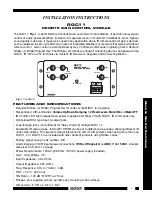
ZED-F9P - Integration manual
• Maintaining a good grounding concept in the design
• Shielding
• Layout optimization
• Low-pass filtering of noise sources, e.g. digital signal lines
• Remote placement of the GNSS antenna, far away from noise sources
• Adding an LTE, CDMA, GSM, WCDMA, BT band-pass filter before antenna
4.6.3 Out-of-band interference
Out-of-band interference is caused by signal frequencies that are different from the GNSS carrier
frequency. The main sources are wireless communication systems such as LTE, GSM, CDMA,
WCDMA, Wi-Fi, BT, etc.
Measures against out-of-band interference include maintaining a good grounding concept in the
design and adding a GNSS band-pass filter into the antenna input line to the receiver.
For GSM applications, such as typical handset design, an isolation of approximately 20 dB can be
reached with careful placement of the antennas. If this is insufficient, an additional SAW filter is
required on the GNSS receiver input to block the remaining GSM transmitter energy.
4.7 Layout
This section details layout and placement requirements of the ZED-F9P high precision receiver.
4.7.1 Placement
GNSS signals at the surface of the Earth are below the thermal noise floor. A very important factor in
achieving maximum GNSS performance is the placement of the receiver on the PCB. The placement
used may affect RF signal loss from antenna to receiver input and enable interference into the
sensitive parts of the receiver chain, including the antenna itself. When defining a GNSS receiver
layout, the placement of the antenna with respect to the receiver, as well as grounding, shielding and
interference from other digital devices are crucial issues and need to be considered very carefully.
Signal loss on the RF connection from antenna to receiver input must be minimized as much as
possible. Hence, the connection to the antenna must be kept as short as possible.
Ensure that RF critical circuits are clearly separated from any other digital circuits on the system
board. To achieve this, position the receiver digital part closer to the digital section of the system
PCB and have the RF section and antenna placed as far as possible away from the other digital
circuits on the board.
A proper GND concept shall be followed: The RF section shall not be subject to noisy digital supply
currents running through its GND plane.
Care must also be exercised with placing the receiver in proximity to circuitry that can emit heat. The
RF part of the receiver is very sensitive to temperature and sudden changes can have an adverse
impact on performance.
The TCXO of a GNSS receiver is a temperature-sensitive device. Avoid high temperature
drift and air convection.
4.7.2 Package footprint, copper and paste mask
Copper and solder mask dimensioning recommendations for the ZED-F9P module packages are
provided in this section.
UBX-18010802 - R08
4 Design
Page 82 of 110
Early production information
















































